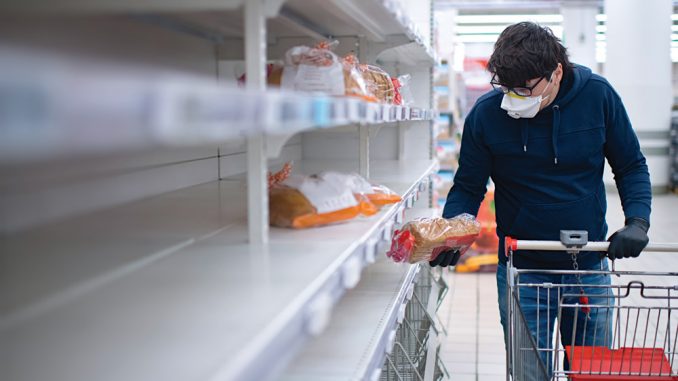
A Review Of The Epic Shopping Patterns Of The COVID-19 Pandemic
Never before in our lifetimes has the world witnessed the complex and deadly impact of the COVID-19 coronavirus. This world-changing event has impacted nearly every facet of mankind’s way of life. From economic impacts and major job losses to the fight to stay healthy, as well as the horrific emotional shock of friends and family who’ve lost loved ones, this virus has shaken the roots of nearly everyone on the planet.
One significant and surprising aspect of the virus’s impact that’s often been overshadowed by the daily case and death counts was the roller-coaster-like panic of buying of groceries and other essential food-related items.

Unlike a natural disaster that usually moves in and out of a specific area relatively quickly, this pandemic spurred, and continues to cause, a buying spree unlike anything seen in modern times. The phases of purchasing food, water and other non-food items were distinct and were the direct effect of what was transpiring on a daily, and sometimes hourly, basis.
I’ve seen this type of buying firsthand in my role as a member of grocery store management. I’ve been on the “front lines” from the start.
To give you some insight into these events from my perspective, I’ll examine those phases and look at what’s occurred and what’s presently in effect. No one knows what the future will look like, especially if the oft-mentioned “second wave” of cases becomes a reality.
Watching the News
All was normal in the United States as reports of a spreading illness in China seeped into our local news. Stories about a highly contagious virus of unknown origin hitting the huge Chinese city of Wuhan caused talk among people at work, but the virus was nothing that would be called a concern or reason to worry.
However, as the virus spread beyond the area and into a variety of countries, Americans began to take notice a bit more closely. News and social media coverage of Wuhan being locked down—with residents having virtually no access to anything outside their apartments—also played on the psyche of people in the States.

Shoppers bought cartsful of groceries during the two to three weeks prior to the country being locked down.
When news reports announced that cases of the COVID-19 coronavirus were showing up here, the rush of panic buying began. Fearing that they, like the people of Wuhan (and, at that time, elsewhere), would be unable to leave their homes for days, weeks and possibly months, everything not nailed down to the grocery shelves was in their sights.
Power Buying for Lockdown
The idea of being locked down at home quickly grew into a very real probability. As a result, people hit the grocery stores in droves.
At my location—and, I’d assume at most retail supermarkets, both large and small—power buying became the order of the day. People had to calculate food needs for their entire family—with no idea when they’d be able to get back to the stores. Spring break was underway at that time, and children were out of school, further adding to breakfast and lunch food needs on the home front.

All types of over-the-counter medicines were purchased and stocked for assisting with the symptoms of the COVID-19 coronavirus.
People shopped as if a major hurricane had been predicted. Fresh meats and poultry, dry grocery goods (including snacks, cookies and sweet treats), were vacuumed up for the kids. Soups, crackers and breads of all types were included in this frenzy—along with just about everything else.
Unlike a disaster, during which power outages might reduce frozen and refrigerator-stored food purchases, this COVID-19 buying binge had no such restrictions. Frozen-food cases were decimated. From frozen pizza and “TV dinners” to French fries and ice cream, the shelves in the frozen food department were emptied quickly and abruptly.

During the first two weeks of power shopping, meats and poultry products were wiped out. Sporadic outages still continue, because meat processing plants have reduced output caused by the effects of COVID-19 on their workforce.

In order to have enough product to serve more customers, purchase quantity limits were put on many key items.
Fresh produce was also hit hard. Unlike grocery store shelves that are deep and hold numerous varieties of the same type of product—and with a backroom loaded up with overstock items—produce racks feature only a few layers of product and little in backstock due to the perishability of the items. The idea of eating healthier to keep a family’s immune system at its peak became pervasive, so produce was picked over, leaving only scraps within the first few days of the onslaught.
The concern of a possible shortage of adult beverages created a surge, not only in cold, in-the-case items, but also in all overstock that had been stored in back rooms. These items were quickly placed on the shelves and, of course, were gone within days.
What wasn’t purchased aggressively? Fancy bakery cakes and pastries were practically untouched, nor were prepared hot foods, soups, ready-made salads, sandwiches and fine gourmet cheeses. It was time to buy the basics for subsistence, not indulge in frivolous items.

Toilet paper—the surprise top purchase at the height of the shopping frenzy— was still difficult to find months after the pandemic began.
“When news reports announced that cases of the COVID-19 Coronavirus were showing up in the United States, the rush of panic buying began.”
Non-Food Essentials
In addition to food, other essential, lockdown-related items were also “power-bought.”
First, water flew off the shelves as if a hurricane were barreling down. From 24-pack singles to gallon jugs and individual bottles, anything and everything labeled “water” was out the door. In addition, water-style drinks, including flavored water, seltzers and infused water, were also in high demand. A person’s faucets would still work and provide drinking water during the pandemic but, with the public almost habitually dependent on bottled water these days, this category was one of the first to be depleted.
Of course, because this was a health crisis, medications were cleared off the shelves. However, what most people didn’t realize was that over-the-counter meds wouldn’t work to cure COVID-19; in fact, they might only aid in alleviating some of the symptoms. But fear is fear, and better to have than not, so all forms of medications were wiped from the shelves in days. These included virus symptom-related pills and liquids, as well as stomach ailment medications (you know—the pink stuff), cough drops and allergy meds.

Although water was still safe to drink from the tap, shoppers grabbed all types of bottled water to store in case the availability of potable water changed.
Also interesting is that medicinal teas were a popular item when the mainstream medicines were all but gone; and, not surprisingly, calming teas, such as chamomile and other variations that featured “stress-ease,” “relax” or “sleep well” on their labels, found their way into numerous shopping carts. With stress at an all-time high for many people, anything that could help ease their minds and bodies was widely purchased.
During the initial mad dash for groceries, toilet paper, bathroom wipes and paper towels were items that few realized were “more valuable than gold,” so to speak. The reason(s) toilet paper was in such high demand—and, at times was sought after far more than valuable food or water products—isn’t clear. However, there were some theories floating around.

Cleaning supplies were cleaned out as fast as key food items when the COVID-19 pandemic hit the United States.

Cleaning items that were labeled as “virus-killing” disappeared from the grocery shelves as soon as the pandemic reached the United States.
Some news reports indicated that because there was a shortage in Australia, some Americans acted to avoid a similar situation, at least for themselves. Others suggested that paper factories would be closed, thus limiting the available supply. However, the basic truth is far simpler and more obvious: With so many people now staying at home—along with their children, who were at home instead of at school—the demand for these paper products would require significantly more quantity than usual. In addition, with rumors being bandied about of a national lockdown for an undetermined amount of time, the possibility of not having such basic hygiene items frightened many. Thus, the somewhat crazy stampede for said items began, and continued throughout the crisis.
Not to be forgotten are those opportunists who saw the chance to make money because of their neighbors’ lack of preparedness. Their selfish attempts to score big during the widespread shortages cannot be quantified for sure, but they certainly had an effect on both the levels of available supplies and the ongoing “feeding frenzy.”

One of the most valuable items during the pandemic was, and continues to be, hand sanitizer.
“The idea to eat healthier to keep a family’s immune system at its peak became pervasive, so produce was picked over, leaving only scraps within the first few days of the onslaught.”
Virus-Fighters
It’s little wonder that virus-fighting merchandise disappeared from the shelves within the first few days of the shopping onslaught. Alcohol wipes, bleach, rubbing alcohol, virus-fighting aerosols and any other products that featured “kills viruses” on their labels were scooped up by the handfuls. Limits on the amount of such products that one person could buy were implemented to slow down the rush and allow others access to those critical products. But, in most cases, this was done too late; and, with products gone, it was, at best, a futile attempt to make sure all shoppers obtained at least some items.
Supply Chain Issues
With the country quickly feeling the effects of limited imports of certain items from other countries, coupled with the inability of domestic vendors to anticipate the exceptional demand, supply lines became strained. Restocking was spotty for the first few weeks after the fear of a lockdown was announced. Entire sections of grocery shelves were bare from front to back. Frozen-food cases had but a few random items (usually those that were so specialized that no one could, or would, benefit from them during the crisis). In the dairy department, eggs and milk—two staples of most American families—were scarce almost constantly and continued to be so for weeks in most locations.

One item that few people would have guessed to be scarce or even non-existent was toilet paper. (Photo: Getty Images)
As soon as product came into the store, that product was sold out. Backstock, which, during normal times, could be difficult to move in quantity, posed no issues at that time. Anywhere there was a “hole” in the grocery section, it was filled with available backstock items, which were soon bought by active, aggressive shoppers.
“Unlike a natural disaster that usually moves in and out of a specific area relatively quickly, this pandemic spurred and continues to cause a buying spree unlike anything seen in modern times.”
Ongoing Shortages
As weeks passed, product shortages and customers’ shopping habits were directly linked to the local, state and national news. For example, if there were reports of beef, poultry or pork shortages caused by plants shutting down due to outbreaks within them, the meat department would be inundated with customers from opening to closing who were trying to secure meat for their families. This would then cause further shortages at the store level due to the greater amount of meat being sold. Simultaneously, the suppliers were unable to ship complete orders, because they, too, felt the pinch of beef and pork production shortages.

Disposable gloves of all types were bought up to help decrease the risk of spreading the COVID-19 virus.
In addition to paper goods being almost constantly out of stock, when some product did reach the store, all of it would be bought within hours. A month and a half after the pandemic began, toilet paper, wipes and other items were not being replenished to a point at which the casual shopper was able to find them without issue. Instead, it was only through sheer luck and providential timing that a shopper could find such goods.
No End in Sight at This Time
As of this writing in late May, there’s no finality to the U.S. COVID-19 outbreak or to the erratic pattern of shopping at most grocery stores throughout the country. As news breaks, the buying agenda of the people around the country shifts accordingly.
The essential lessons that can be taken from the events of the pandemic hitting the United States are to stay prepared with plenty of food and other everyday supplies for your family; stay physically safe; and stay optimistic that you’ll get through this crisis healthy and ready to tackle whatever is thrown at you next.

Face masks were scarce at the beginning of the pandemic, with many people opting to make their own. They’ve since become somewhat plentiful as more stock arrived for those who need and want them.

On-the-go shoppers often bought and then brought groceries to the doorsteps of family and friends who couldn’t (or didn’t want to) venture out to the store.
The United States Adapts to Stay Healthy
Most, if not all, grocery stores were literally on the “front lines” of the COVID-19 pandemic. Like healthcare workers and first responders, workers in food stores faced safety concerns every day while interacting with panicked, stressed and short-tempered customers. As a result, safety measures were put into place to protect the cashiers, food preparers, stockers and store management.
Face coverings. From cotton masks to bandannas to surgical face coverings, store employees were required to wear nearly anything they had that would cover their faces and help stop the spread of the virus. In addition, customers were asked to adhere to a face mask protocol. To no one’s surprise, most customers participated—with no complaints or resistance.
Social-distancing markers. Tape lines were put down on the floor to signify the space for customers to stand in while waiting to check out. Six feet apart was the norm—causing checkout lines to appear longer than they really were as customers and carts lined up from the cashier to nearly the middle section of the store.
Plexiglas shields. At the cashier, distancing between the money-taker and the customer was nearly impossible. The solution was a Plexiglas barrier blocking any droplets that could be transmitted between the two people. It’s simple and effective, as long as the shopper and employee keep this barrier between them.
Crowd control. The number of customers in the store at one time was also regulated; and when a set maximum number of people inside was met, the door was monitored, and additional guests were stopped from entering. When shoppers left the store, an equal number of eager guests was allowed in.
Sanitizing nearly everything. “Sanitize” became a true buzzword in every aspect of normal store operations—from hand sanitizer for employees to using sanitizing liquid on returned shopping carts. If something had the potential to have the virus on its surface, virus-killing alcohol or other approved chemicals were almost guaranteed to be applied on a nearly hourly basis.
Buying From Afar

With social distancing now the new normal in today’s pandemic world, along with some people’s fear of being inside a grocery store, many shoppers have chosen to buy from the comfort of their own homes via online ordering and home delivery services.
Several similar services, such as Instacart, FreshDirect and Amazon Prime, have now been used by millions of people for stay-at-home buying. Grocery chains have also added/expanded home delivery service to meet customer needs.
Not unlike services such as Lyft and Uber (many of whose workers have now switched to shopping services due to the drastic decline in vehicle travel), a person can become a shopper whenever they have the time—and an Internet connection. The amount of online and phone app-based buying skyrocketed during the lockdown. Many “regular” customers were replaced by quick-moving list-gatherers—complete with their phones in hand and cartsful of groceries in the check-out lanes for remote shoppers.
Editor’s note: A version of this article first appeared in the September, 2020 print issue of American Survival Guide.





Be the first to comment